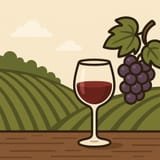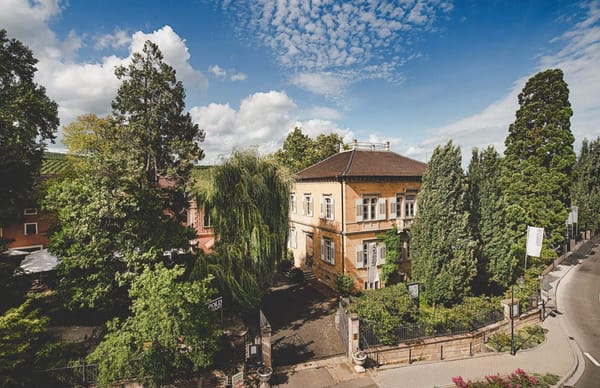See It First - The Power of Sight in Wine Tasting 🍷👁️
Before you sniff or sip, your eyes are the first to taste. Discover how sight reveals a wine’s age, style, and story. From color to clarity and legs, learn why seeing is believing on your wine journey.

Before your nose dances with aromas or your tongue plays with flavors, your eyes get the first sip of the story.
Yes, wine tasting starts before tasting.
Imagine: the sun dips low, a glass is raised, and light catches swirling liquid like poetry in motion. That moment is not just beautiful - it’s meaningful.
Sight gives us clues. It whispers secrets about what lies ahead. And in the world of wine, every clue counts.
As the saying goes:
“Wine is sunlight held together by water.” — Galileo Galilei
But before sunlight turns into flavor, it turns into sight.
Why Sight Matters: More Than Just a Pretty Hue
The color, clarity, and movement of wine aren’t just there for Instagram-worthy shots (though, let’s be honest — they help 🍇📸).
They reveal critical aspects about the wine’s:
- Age
- Grape Variety
- Fermentation Method
- Alcohol Content
- Winemaking Choices
Aged wines deepen and soften in color. Young wines glow with vibrant energy. Oak-aged wines can wear a deeper robe, while unoaked wines stay lighter and leaner.
Seeing is believing — and predicting.
Even before your nose joins the conversation, your eyes are already sketching the story of the wine in your glass.
👀 Step 1: Create the Stage — The Right Viewing Conditions
Great wine deserves great lighting.
To properly inspect a wine:
- Use natural light if possible. Artificial light can alter the true color.
- Hold the glass at a 45-degree angle. This allows you to inspect the gradient from core to rim.
- Use a white background. Think white tablecloth, napkin, or even your tasting notebook. This provides contrast.
- Avoid patterned or colored backgrounds. They distort the reading — and trust us, paisley prints don’t help.
Remember: clarity comes with clarity. Set the stage properly.
🎨 Step 2: Analyze the Color
Color is one of wine’s loudest visual storytellers.
White Wines
- Almost Colorless: Fresh, young wines like Pinot Grigio.
- Pale Yellow with Green: Youthful and vibrant (Sauvignon Blanc).
- Golden Yellow: Barrel-aged or aged wines (Chardonnay).
- Deep Gold: Sweet or oxidized wines.
Red Wines
- Purple: Young and bold (Syrah, Malbec).
- Cherry Red: Medium-aged or lighter reds (Pinot Noir, Gamay).
- Ruby: Balanced and middle-aged (Merlot, Sangiovese).
- Garnet/Brown: Mature reds (Cabernet Sauvignon, Barolo).
A rule of thumb?
👉 White wines darken with age.
👉 Red wines lighten with age.
Wine doesn’t lie — but it does age gracefully.
A really nice chart showing what the different wine colours mean.
💧 Step 3: Assess the Clarity and Purity
Cloudy wine? Not always a flaw.
Modern winemaking often leans toward unfiltered, natural styles, leaving behind small particles that do no harm. In fact, they may indicate minimal intervention winemaking — a badge of purity.
Still, most wines should be clear.
Look for:
- Crystal clear brilliance: Often seen in commercial wines.
- Slight haze: Natural and unfiltered wines.
- Sediment or tartrates: Normal in aged wines or those stored in cold conditions.
Tip: Swirl gently and see if anything dances or floats.
🕯️ Step 4: Viscosity — “Legs,” “Tears,” and What They Mean
Swirl the wine, and watch.
Those streaks slowly crawling back down the glass? They’re called legs or tears, and they tell you about:
📈 Alcohol content: Higher alcohol = thicker, slower legs.
🍬 Sugar content: Sweeter wines also show more legs.
But here’s the truth:
“Legs don’t measure quality — they measure richness.”
So, don’t judge a wine solely by how much it cries.
🫧 Step 5: Look for Bubbles (Even in Still Wines)
Bubbles are the loud guests at the party.
In sparkling wines, they are the stars.
In still wines, they could be:
- Fresh bottling (like Vinho Verde).
- Natural fermentation remnants.
- A fault (rare, but possible).
Tiny bubbles in still wine? Often harmless.
Big, aggressive bubbles? Not supposed to be there.
What Sight Can’t Tell You (And That’s OK)
While appearance reveals a lot, it doesn’t tell you:
- How the wine smells
- How the wine tastes
- How it feels on the palate
For that, you need to sip and savor. But seeing gives you the head start. Like reading the blurb on a book before turning the first page.
🍇 Tobi’s Tip — Learn to Trust Your Eyes
Practice makes perception.
At your next tasting, compare the colors of three different wines side by side.
🔍 Ask yourself: Which looks youthful? Which looks serious and aged? Which sparkles with freshness?
The more you look, the more you see.
The more you see, the more you understand.
🎶 Wine & Music Moment
Sight is all about setting the mood.
For that, nothing fits better than this timeless classic:
🎵 “Summertime” – Louis Armstrong & Ella Fitzgerald
Smooth. Flowing. Dreamy.
As you swirl, tilt, and observe — let Ella’s velvety voice and Louis’ warm trumpet transport you.
Like wine, this song teaches us:
Slow down. Enjoy the view. Feel what’s beneath the surface.
Next up? Smell.
The next step on your tasting journey dives deep into aromas, from zesty citrus to sultry forest floors. Stay tuned.
Until then —
👁️ See it.
🍷 Feel it.
🎶 And let it move you.
– Tobi 🍷




